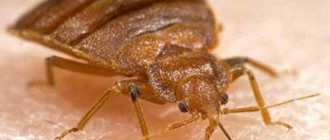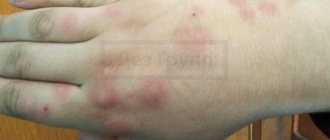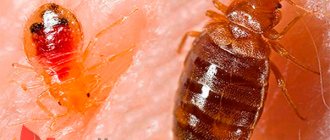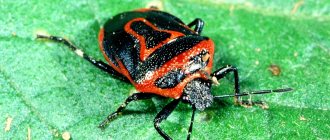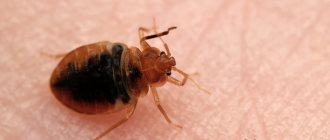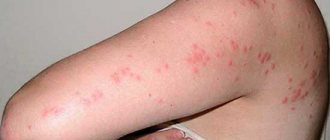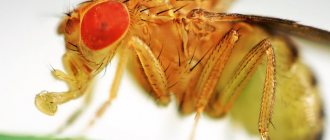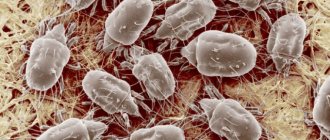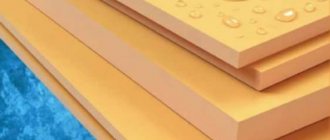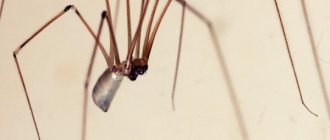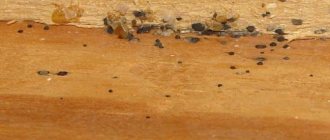Clothes bugs got their name due to their localization. They are also called linen, bedding, household, room. Despite the fact that inconspicuous insects do not pose a mortal danger, their appearance in an apartment is comparable to a natural disaster. It is extremely difficult to remove bedbugs. Even if the entire population is destroyed, and one fertilized female remains, the colony will be restored in 30-45 days. Therefore, treating things and clothing against bedbugs is a mandatory item in the pest control program.
Can bedbugs live in clothes?
Bed bugs feed on human blood and try to stay as close to the food source as possible, that is, to humans. That is why their usual habitat is a bed, mattress, sofa, as well as bedside tables, chests of drawers, and cabinets standing next to them. Bedbugs hide where it is dry, dark, comfortable and warm for them. These can be the back walls of cabinet furniture, as well as internal shelves, walls, drawers. Insects lay eggs everywhere, including on fabric, clothing, books, and inside bindings. If things lie motionless for a long time, bedbugs can make a nest in them.
How bedbugs get into closets with clothes:
- along with pajamas after a night's sleep on a bed infested with parasites;
- along with items purchased second-hand, at flea markets, second-hand stores, or even in regular stores, where a variety of people can try them on;
- along with bedding and towels.
The closet itself may also be infected if it was brought from an apartment with bedbugs or from another place where parasites could live. Bedbugs can also crawl into it from the bed if the closet is very close to the bed.
Can insecticides be used?
Most insecticides are dangerous to humans - they cause food poisoning, allergies and irritation of mucous membranes. However, most insecticides are deactivated by alkalis - if, after disinsection, the poison is neutralized in an alkaline environment, then things can be used without harm to health. The most common alkali used at home is regular baking soda. Prepare a soda solution and rinse the treated linen and clothing in it. You can use non-toxic insecticides - after using them you only need to vacuum the fabric.
What about the smell? The answer is simple - you need to use modern insecticides. The latest generation of anti-bedbug drugs have a weak odor or no odor at all. Which insecticide to choose is up to you. There is a wide selection of drugs on the modern market for a variety of purposes.
How to detect bedbugs on clothes
First you need to determine that pests live not only in the bed, but also on clothes. To do this, you need to carefully examine all the furniture where clothes are stored. It is advisable to remove all items from closets and chests of drawers. But you need to remove them carefully so that the bedbugs - if there are any - do not run away and hide in other pieces of furniture. If the closet is large, you can shine a flashlight inside - from the bright light, insects will begin to move chaotically and try to hide. It also makes sense to sniff: if there are a lot of bedbugs, then there will be a characteristic smell in the closet or chest of drawers, reminiscent of an unpleasant cognac aroma.
The nest is usually quite large, containing adults, eggs, excrement, insect remains and other dirt. There can be several nests in one closet.
Bedbugs in clothes do not get inside objects through fabrics, since they cannot gnaw through them. Their proboscis can only pierce human skin to suck blood. Bedbugs move along the surface, getting into folds, pockets, seams, and loose hems. Very rarely, bedbugs live in fur, since the texture of the fur, hairs, and lint are not very convenient for their movement.
Light
The fact that bed bugs are very afraid of light is known to many. It is explained by the fact that bloodsuckers lead an active lifestyle at night. Their activity peaks during the hours of a person's deepest sleep (3-5 am). During the day, bloodsuckers prefer to hide in their shelters.
You can make sure that bed bugs are afraid of light by discovering their habitats. It is enough to turn on a light bulb at night or raise the mattress, and the parasites, in a state of panic, scatter in different directions, trying to hide in a secluded dark place. However, this feature is not applicable for pest control. After all, insects will only move around the apartment, finding more reliable shelters for themselves.
How to get rid of bedbugs on clothes
Cleaning clothes from bedbugs is quite simple. They are afraid of heat, so the easiest solution is to wash all washable clothes at temperatures above 65 degrees. Adult insects die already at 40 degrees, but eggs are more tenacious, so it’s better to play it safe. There is no need to use insecticides or any other chemicals. There is also no need to use traditional methods such as treating things against bedbugs with vinegar, turpentine, or ammonia. Insects, of course, are afraid of a strong smell, but you have to wear these things and “smell” them. Regular washing with hot water and ordinary household chemicals is sufficient. After washing, it is advisable to iron the items to be sure.
Bed linen that is stored in a closet or chest of drawers next to clothes should also be washed and ironed. If shoes are stored there, they can be washed thoroughly, as they may contain eggs or adult bedbugs that accidentally got there.
Appearance of bloodsuckers
Bedbugs are small insects 3-8 mm in length . Most often they are brown in color - from light to dark. After the blood is pumped, they acquire a reddish tint or turn black. The lifespan of an individual is one year . The female is capable of laying up to 500 eggs and in 40 days many new specimens hatch from them.
If there is a shortage of food, they can hibernate and emerge from it when favorable conditions arise. When the temperature drops to minus 15, the insect dies . The bug emits a characteristic odor when crushed.
Clothes bugs - photos of insects:
How to treat clothes that can't be washed
Bed bugs living on clothing can be frozen out. This is the most ancient and very effective way to combat parasites. When the temperature drops below -20 degrees, things are taken outside or to an open balcony and left there for several hours or overnight. The parasites are guaranteed to die, as well as their eggs. If it's warm outside, you can put things in a sealed plastic bag and put them in the freezer, if dimensions allow. For complete destruction, at least three hours must pass, and preferably more.
After such freezing, the clothes need to be shaken thoroughly to remove the remains of bedbugs and their eggs.
There is another way - the reverse of freezing. This is the treatment of clothing with a steam generator. Hot air directed directly at them kills bedbugs and their eggs. It is necessary to process things from all sides, in seams, folds. You need to process carefully, without missing any space for processing.
Exposure to steam or frost is detrimental to insects, but it is important to remember that not all fabrics can withstand treatment with hot air. They can fade, become deformed, and decrease in size.
If it is not possible to freeze or heat the item, you can take it to the dry cleaner, but warn that it may contain bedbugs.
Which one do they like?
Insects prefer models with numerous seams , in which they can easily hide. They are especially likely to settle in pajamas, home clothes, and underwear, since this is where body odor lingers the most. If you notice small brownish spots on things, it means they live on it.
INTERESTING! Can bedbugs bite through clothing? No, their mouthparts are not so powerful for this. Although their bites are unpleasant, especially in children.
But insects do not like fur products , because their paws cannot catch on the fur and they are not able to move on it. In addition, fur models have insufficient contact with the body, so pests have nothing to do there.
What else must be done when removing bedbugs from clothes?
Regardless of whether bedbugs live on clothes or inside a closet, dresser, or nightstand, it is very important to treat the furniture. It is better to do this with insecticides. For example, the Superpower spray against bedbugs from Medilis is convenient. You can also use Tsiper, Permifen, Neo, Super. They kill insects when treating surfaces. Chemicals must be used in strict accordance with the instructions; personal protective equipment must be used when working with them. You cannot wash clothes in them; they are used only for processing furniture where these clothes are stored.
If bedbugs are found, you can and should empty the closets and send clothes to be washed or frozen. Wash the cabinets themselves with an insecticide solution or thoroughly spray the inside with superpower anti-bedbug spray from the MediLIS company. After the time required for exposure, the furniture is thoroughly washed and ventilated. It is important to treat all shelves, drawers, top and bottom panels, side walls, doors from the inside, without leaving a single untreated area. You also need to move the closet away from the wall, clean its back wall, check the place on the closet - it is there, in the dust and darkness, that bedbugs prefer to settle in comfort.
To repel bedbugs, you can put sachets with mint, wormwood, tansy, and lavender in a cabinet treated with insecticides. This will help give things a scent and repel parasites.
Washed and ironed clothes, cleared of bedbugs, are returned to their place in the closet only after the furniture and the entire room have been completely treated from insects. If you don't treat the furniture, bedbugs will repopulate your clothes. The fight against parasites should always be comprehensive. It is impossible to destroy them in one part of the apartment and leave them in another. They will very quickly restore the population and occupy the entire home. They easily migrate around the room - between the bed, sofa, cabinets. So if you find bedbugs in clothes, you need to start poisoning bedbugs everywhere, and not just destroy them in personal belongings.
Prevention of insects
To prevent infection of a mattress, bed or other items, you need to follow the recommendations:
- they close access to the apartment: install a fine-mesh mesh over the opening of the ventilation duct, fill the cracks with a solution (on the floor, walls, in the ceiling where pipes pass, on windows and door blocks);
- place cotton pads soaked in turpentine, ammonia or other strong-smelling substances under the mattress;
- Bedbug repellents should not be applied to the surface of the mattress;
- leave bitter herbs (wormwood) inside the bed frame;
- regularly inspect the sleeping area.
After removing bedbugs, you should regularly inspect your sleeping area.
Would a mattress cover help?
If such a product is hermetically sealed, then this can be one of the effective ways to protect against bedbugs. Parasites do not damage the tissue with their mouthparts, so they cannot get inside on their own. However, it is not advisable to purchase a cover if the mattress is inflatable. At the same time, the risk of bedbugs getting inside is zero. This feature is explained by the fact that if the integrity of the coating is damaged, the latex mattress will deflate, which in itself indicates problems with it.
Sealed cover protects the mattress from pest infestation
Reviews
Raptor
Olga, Udmurtia: “When I bought a used sofa, I didn’t immediately realize that it had bedbugs. It was summer, hot, mosquitoes. I attributed my bites to them. My bedding set was dark, with a black pattern. One morning I saw THEM and panic seized me. How so? After taking time off from work, I ran to buy all the products I could find, as long as they had the signature “from bedbugs” on them. Having processed the entire apartment, the next morning I did not find a single corpse, and only a few living insects hastened to hide from the sunlight. I went shopping again and purchased a Raptor. After thorough treatment with this product, I counted more than 50 dead bodies. Vacuumed them. I didn't see any more bedbugs. After some time, I noticed that any insects in my apartment did not stay long. The flying mosquitoes and flies fell dead. I definitely recommend it."
Lyudmila, Moscow: “A friend advised me to use the method of exterminating bedbugs. She also rented out her steam cleaner - it looked like a teapot with a long spout. We found a lot of bedbugs behind the wallpaper, at the very top, where I wouldn’t even have thought to look if I hadn’t read it on the Internet. I did the treatments every 3 days, then less often, once a week, and so on for a whole month. Although a lot of effort was spent, there are no pests!”
On a note! If bedbugs appear in an apartment, you should use proven methods - chemical or temperature treatment. If you can’t remove the parasites yourself, you can call special services.
*Prices are current as of August 2022.
Expert opinions
Some professional pest control methods are based on the characteristics of bedbugs, especially their survival temperature. But it is difficult to carry out high-quality self-treatment of the premises. The survival rate of insects is very high for several reasons: technology is not followed, incorrect temperature and short exposure time.
Experienced specialists take into account many interrelated factors: the degree of infestation, the time of appearance of insects, the total area of the room and the features of the building. Of the professional steam treatments, cold and hot mist are the most effective.
In both cases, a fine mist of insecticide is sprayed by a steam generator. Hot fog has an additional destructive effect - temperature. The spectrum of action of professional steam treatment is very wide - the fog kills bedbugs, ants and cockroaches. Maximum steam saturation ensures the destruction of the entire population.
Bedbugs are afraid of too high or low temperatures. However, local steaming or partial freezing is not enough to destroy them. An integrated approach is required, which can only be provided by a professional pest control service.
We carry out heat treatment
To do this, every single thing is collected and loaded into the washing machine. Remember about linen and towels. Processing requires a high temperature, which will not be below the 50 pointer. It is best to set the mode to 90 degrees. What if the machine is missing? Then the clothes are boiled. Of course, if they are not silk or wool. After washing, clothes are hung in the sun.
After weathering, use a hot iron for ironing. It is also effective to treat clothes using steam. If you have a steam generator, then use it for furniture, treat every crack and corner in the apartment.
When processing fabrics, pay attention to the recommendations on the label. This will determine whether the item can be washed at high temperatures. If the problem with bedbugs appeared in the summer, then it is even easier. Things are left in a bag outside in the hot sun. However, the temperature should not be below 50 degrees. This way you can process your clothes yourself for several days.
Disinsection methods
There are 6 ways to clean clothes from insects and their eggs - each has advantages and disadvantages.
“Suspicious” items can simply be washed in hot water. The water temperature when washing should be at least 50 degrees. Of course, the ideal option would be a temperature of 90 degrees, but not every item can withstand such washing - especially silk or wool.
If the house does not have a washing machine, then contaminated linen and clothes can simply be boiled. You shouldn’t keep your laundry in boiling water for a long time, it won’t add durability to your clothes - 2-3 minutes will be enough.
If signs of poisoning appear...
Let us repeat once again: in our practice there has never been a case of poisoning of an adult or child, or domestic animals with insecticidal agents with which we treat the apartment. However, theoretically, poisoning can occur if safety rules are violated (a person without a respirator enters the apartment during treatment or before ventilation is completed), or if there is a high sensitivity to the drug.
Signs of poisoning are:
- Salivation
- Tearing
- Bleeding from the nose
- Dizziness
- Nausea
- Unpleasant taste in the mouth
If any of these symptoms appear, you need to go outside and breathe. Here the condition quickly returns to normal.
It only makes sense to use agents such as activated carbon or other sorbents if the insecticide gets into the digestive tract. This practically never happens.
Small pets (mice, hamsters) and various cold-blooded animals (amphibians, reptiles, fish) can be quite sensitive to the agents. The former only need very small amounts of the product to cause poisoning; the latter are very sensitive to insecticides due to the specific nature of the enzymes in their body. Therefore, by the way, before treatment, aquariums must be tightly covered with a cover glass and cloth so that the insecticide does not get into the water.
In any case, after treatment, small animals are brought into the apartment in cages, aquariums or terrariums. If everything here is well ventilated, there will be no insecticide in the cages and aquariums themselves, and since the animals do not move around the apartment, they will not come into contact with the drug on the floors and walls.
If you still have any questions, you can call our consultants and ask them. We will understand your situation and tell you what exactly needs to be done.
Professional destruction based on the temperature method
Sanitary and epidemiological services use two methods - hot and cold fog treatment. Combines the effects of temperature with insecticides. The methods give 100% results and are considered the most effective.
Hot fog treatment
Air is pumped into special equipment - a fog generator. An insecticidal substance is also supplied there. During operation, the poison comes out along with hot air in the form of tiny droplets. A cloud of fog is created in the room, which lasts for 10 hours. During this time, hot particles of the insecticidal agent penetrate into all the cracks of the room. As they cool, they settle on the surface, thereby creating a layer of poison. Professional processing gives 100% results. However, it is recommended to enter the premises every other day. Otherwise, you can get poisoned yourself. Hot air slightly increases the humidity in the room, which is one of the advantages of the method.
Cold fog treatment
The operating principle is similar. Only it is not hot air that comes out, but cold air. The molecules of the insecticidal agent are much larger, so they settle faster. The cloud of fog lasts only 4 hours. During this time, the poison spreads throughout the room. The main task is performed by an insecticide. It is he who gradually poisons the entire generation of bedbugs. This method significantly increases the humidity in the room, and household appliances may be damaged. Before processing, you need to worry about its safety.
The steam generation method differs from conventional disinfestation with an insecticidal agent in its ability to evenly distribute the poison over all surfaces. This is almost impossible to do when using a sprayer. You must follow all the recommendations of specialists and do not enter the premises ahead of time. In developed countries, after disinsection of an apartment, people are not allowed to enter it for about a week. Which is very correct from a security point of view.
